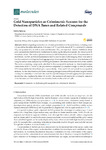Gold Nanoparticles as Colorimetric Sensors for the Detection of DNA Bases and Related Compounds

Use this link to cite
http://hdl.handle.net/2183/25880Collections
- Investigación (FCIE) [1227]
Metadata
Show full item recordTitle
Gold Nanoparticles as Colorimetric Sensors for the Detection of DNA Bases and Related CompoundsAuthor(s)
Date
2020-06-23Citation
Iglesias, E. Gold Nanoparticles as Colorimetric Sensors for the Detection of DNA Bases and Related Compounds. Molecules 2020, 25, 2890. https://doi.org/10.3390/molecules25122890
Abstract
[Abstract] Results regarding interaction of colloidal gold solutions with nucleobases, including uracil (U), as well as its sulfur derivatives, 2-thiouracil (2TU) and 4-thiouracil (4TU), cytosine (C), adenine (A), and guanine (G), as well as urea and thiourea (TU), are reported. Anionic stabilized citrate gold nanoparticles (AuNPs) were synthesized by reducing the tetrachloroaurate (III) trihydrate with trisodium citrate. The surface plasmon resonance (SPR) band was used in the characterization of synthesized AuNPs, as well as transmission electron microscope (TEM) imaging, which was used in the characterization of dispersed and aggregated gold nanoparticles. Interactions of nucleobases with the gold surface was analyzed by following the plasmon absorbance band red shift of the AuNPs. The sulfur-containing compounds adsorbed to the nanoparticle surfaces by chemisorption-type interactions; with TU and 4TU, the process is accompanied by a sudden change in color; in contrast, 2TU forms stable functionalized gold nanoparticles. Urea and U do not adsorb to nanoparticle surfaces, but the other heterocyclic bases containing nitrogen interact effectively with the gold surface, causing the assembly of nanoparticles, even though the interparticle self-aggregation process was slower than that mediated by either TU or 4TU. The method is efficient in the colorimetric detection of nucleobases and derivatives at concentration levels on the order of 1 µM.
Keywords
Biosensors
Nucleobases
Gold nanoparticles
Colorimetric detection
Nucleobases
Gold nanoparticles
Colorimetric detection
Editor version
Rights
Atribución 4.0 Internacional
ISSN
1420-3049






